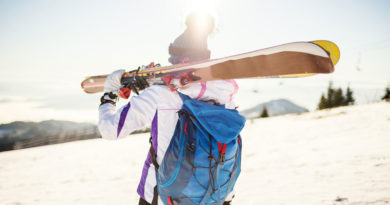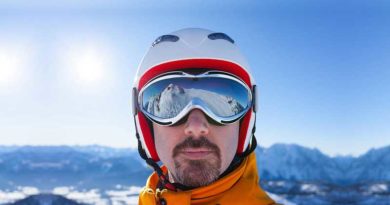Best Budget Ski Boots of 2022
Ski boots are a critical part of your skiing kit. But not everyone needs a $1000 high-end do-it-all pair of boots. Not all of us are Olympic athletes. Most of us are amateurs and some of us are beginners looking for fun without going broke. A budget option is sufficient enough to satisfy all our needs. If you are one of those who are looking to have fun and are on a budget, then look no further.
So here is the list of top ski boot models that you can get at an affordable price.
1. Nordica Cruise 70

Last: 104mm
Flex: 70
Binding Compatibility: Alpine (optional GripWalk)
Ability Level: Beginner
Nordica Cruise 70 is an entry-level ski boot that checks all the right boxes. You would be surprised by the features that it has to offer on a budget. With its soft flex, it is aimed at beginners. It is a great-looking boot with all the essential functions required for beginners. Despite the solid build of the shell, the Cruise has a classic 4 buckle design. What’s more, is that the buckles are aluminum while other brands use two or three plastic buckle setups at a similar price point. The buckles themselves are extremely durable and provide a customized fit. The buckles also allow micro-adjustments to further improve the fit.
The Cruise 70 is all about comfort. So much so that comfort has been preferred over performance in this boot. It even features a heat-moldable liner which is a standout feature at a budget or entry-level price point. A wide 104mm last can accommodate wide feet so you don’t feel stuffed in it. When it comes to performance, however, this is where the Cruise 70 lacks. The soft flex of the boot makes it ideal for beginners but it also compromises efficient energy transfer. Those who are eager to make quick turns should avoid this boot. The Cruise 70 features ISO 5355 Alpine soles only.
What I like: Comfortable, flexible, and a great option for beginners
What I don’t like: Low-performance ceiling, can be wide for some skiers
See the Nordica Cruise 70 See the Women’s Cruise 65
2. Rossignol Evo 70
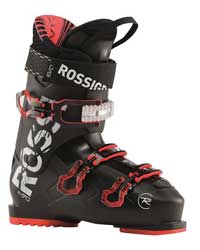
Last: 104mm
Flex: 70
Binding Compatibility: Alpine
Ability Level: Beginner-Intermediate
Budget options are often entry-level and so is the Evo 70 by Rossignol. It is a great boot for those who are looking to jump out of the rentals and want a pair of boots. There is nothing fancy going on here and all the extras have been stripped off from this boot. Being a beginner boot, it should be obvious that this boot has a soft flex. You don’t get a heat-moldable liner like in the Cruise 70 above. But then, it is a few bucks cheaper than the Cruise 70. You get a generic liner that is fairly comfortable with nothing much to talk about.
The shell of the Evo 70 is nicely shaped. The shape of the boot makes it look attractive. The Evo 70 offers a 3 buckle setup. Thankfully, the buckles are aluminum instead of plastic which makes them reliable. The power strap is a reliable one and together with the buckles, it allows for a custom fit that makes the boot feel secure. Again, just like the Cruise 70 above, this is an entry-level boot. It provides entry-level performance. If you are a fast learner looking to progress quickly through your ski lessons, you should put in a few bucks and look for something more suitable for progressive riders.
What I like: Easy to put on and tighten down, comfortable, looks good
What I don’t like: Runs a little large but you can always use thicker socks
See the Rossignol Evo 70 See the Women’s Track 70
3. Tecnica Mach Sport HV 90
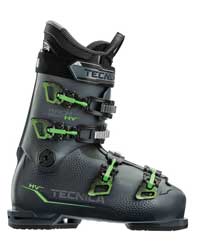
Last: 103mm
Flex: 90
Binding Compatibility: Alpine (optional GripWalk)
Ability Level: Intermediate-Advanced
Tecnica is a respected brand in the sports world. Their Mach1 is among the favorite top-end downhill models. Being a low-priced sibling, the Mach Sport HV 90 also gets some touches from the Mach1. The HV 90 is for those who are looking for ease of use and warmth in their boots. These are soft boots so you won’t be wasting half of the season breaking in these boots. They are comfortable out of the box. Just put them on and off you go to have fun. The HV 90 has a 103mm wide last which is smaller than 104mm but the fitting in the rest of the boot is generous. The generous all-around fitting makes it a problem to fit people with narrow legs. So, if you have wide toes and narrow legs, you are done!
In terms of flex, the HV 90 is a step up from the Mach Sport HV 80, having a flex rating of 90, hence the 90 in its name. The flex rating of HV 80 should be obvious now and so is the 70 in the boots above. But anyway, a higher flex rating makes it a great choice for fast learners who are looking for stiffer boots. A 4 aluminum buckle setup with micro-adjustment provides a secure, custom fit. It has a cozy liner that keeps the feet warm. The HV 90 comes with ISO 5355 replaceable soles but GripWalk soles are sold separately.
What I like: A good balance of price and features
What I don’t like: Advanced skiers may want a little more stiffness, too wide for narrow feet
See the Tecnica Mach Sport HV 90
4. Dalbello Jakk

Last: 103mm
Flex: 80
Binding Compatibility: Alpine
Ability Level: Beginner-Intermediate
The Dalbello Jakk is popular among freestyle riders. It has a lightweight design that provides comfort but holds up when it comes to performance. It has a soft flex making it suitable for beginners and provides a lot of features that make it an attractive budget option. The Jakk features Dalbello’s Cabrio design which is a unique 3-piece shell design. It provides dynamic rebound improving the performance of the rider. It also features a hike/ride mechanism that allows you to walk in these boots.
The liner is excellent. It is a thermoformable liner just like the Nordica Cruise 70 above. Both of these boots have almost the same price so a heat-moldable liner makes sense. The Jakk also features Dalbello’s Contour 4 technology which provides comfort in 4 critical regions; ankles, heel, navicular, and the 5th metatarsal. There are 3 aluminum buckles on the Jakk. The buckles are also micro-adjustable. Along with the comfort liner, and Contour 4 technology, the buckles provide a comfortable, custom, secure fit that makes for an enjoyable ski experience. The Jakk also features Dalbello’s patented replaceable heel and toe protectors. The protectors contribute to the longevity of the boots. The Jakk comes with ISO 5355 Alpine soles which are replaceable. The GripWalk soles are sold separately.
What I like: The soft-to-medium flex is great for all ability levels with good stability and mobility.
What I don’t like: Questionable durability
5. Nordica Sportmachine 80

Last: 102mm
Flex: 80
Binding Compatibility: Alpine
Ability Level: Beginner-Intermediate
Nordica’s Sportmachine collection is a step down from its well-respected Speedmachine collection. Is Sportsmachine is Nordica’s mid-range lineup with an emphasis on comfort rather than performance as in Speedmachine. It has a soft flex but not the softest which makes it suitable for progressing beginners. It is also a good choice for skiers who are looking to dump the rentals and buy their first pair of ski boots. If you are one of those mentioned people, then Sportmachine 80 should be on your radar.
The Sportmachine 80 has a plush liner to make it comfortable. The tip of the boot features soft plastic which makes it easier to put on and take off. The boot also features a 4 buckle setup with aluminum buckles but without micro-adjustability. The last is 102mm so if you have wide toes, this isn’t for you. Like the Tecnica Sports HV 90, the Sportmachine 80 is also a stripped-out variation of high-quality resort boots. Tecnica gets a slight edge having better quality and a customizable shell, but the idea is the same. The overall setup of both the boots is similar. It should come down to fit and availability.
What I like: Good option for intermediate skiers with wide feet
What I don’t like: Average performance
See the Nordica Sportmachine 80
6. Atomic Savor 80
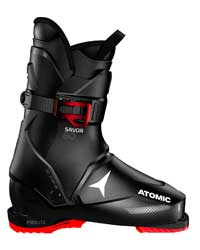
Last: 104mm
Flex: 80
Binding Compatibility: Alpine
Ability Level: Beginner-Intermediate
The Atomic Savor 80 is for those looking for ease of use. They have a very simple to use design with old-school styling. It is especially great for first-timers as it makes a lot of sense to them. They don’t have to bother with different adjustment settings Savor 80 only has a single buckle and a wide opening. You just undo a single ratchet strap, put your foot in handsfree, buckle up, and go. That’s it! It’s that simple. The soft flex is suitable for first-timers and beginners.
The liner is decent and it uses body heat to mold to the shape of the foot. It provides much better comfort and it is a loved feature in the budget or an entry-level series. Savor 80 also features a streamlined construction which contributes to its lightweight. But of course, some problems are to be expected in a single buckle design. A single buckle design lacks the fit that three or four-buckle designs provide. The 104mm wide last further highlights the lack of buckles. Lack of precision and inefficient power transfer are a couple of problems that arise from an improper fit.
What I like: A good option for no-frill skiers who just want to have fun on the slopes.
What I like: A little more expensive than some other options.
7. Lange LX 90
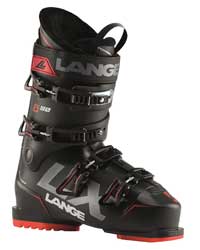
Last: 102mm
Flex: 90
Binding Compatibility: Alpine
Ability Level: Intermediate-Advanced
Lange is a respectable brand and it doesn’t usually involve itself in the beginner market. But when it does, everyone knows it’s going to be a treat. The LX 90 is just that, a treat of a boot to have. It is an entry-level boot with intermediate-level features. It is a little stiffer on the flex rating with a value of 90 but it’s still soft enough for beginners. It is suitable for fast learners who will quickly outgrow a boot with soft flex. But the extra stiffness also makes it a considerable option for intermediates.
LX 90 has a stiff mono-injected shell that allows high-level power transmission which should be expected from a performance-oriented boot. The Dual 3D Comfort Liner provides good comfort for longer sessions. It would have been great if Lange had provided the LX 90 with a heat-moldable liner. The LX 90 features a 4 buckle system. The buckles are aluminum and they are strong. Overall, the buckles and the power strap are of far better quality than in other boots. The boot has a 102mm wide last. It is a good quality boot for a low price. But the price is still above the other entry-level boots.
What I like: Soft lining, out-of-the-box comfort, fits well, good performance on slopes
What I don’t like: Slightly expensive than other entry-level options.
See the Lange LX 90 See the Women’s LX 90
8. Salomon X Access 70
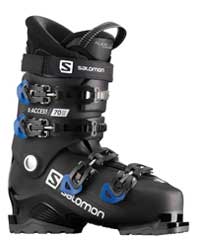
Last: 104mm
Flex: 70
Binding Compatibility: Alpine
Ability Level: Beginner-Intermediate
The Solomon X Access 70 is an entry-level boot with nothing fancy going on. It is an essential ski boot that would be fine for you if you are a beginner. It has a soft flex since it is aimed at beginners at the parks. The twin frame technology of the Access 70 provides decent support and response. The liner is the Flex Comfort Liner which flexes around the calf and the ankle reducing pressure points. A calf adjuster accommodates all leg shapes quickly and easily.
The boot has a 104mm wide last which can accommodate wide toes. The Access 70 features 4 riveted plastic buckles which are sort of disappointing because the Access 70 has a similar price as the Rossignol Evo 70. Being a beginner boot, you shouldn’t expect too much from the Access 70. It performs reasonably well but it doesn’t perform like some top-end models. If you want a stiffer boot, then you can opt for the Access 80 for which you would have to pay an extra $50-60. The Access 70 comes with ISO 5355 Alpine soles that are not replaceable.
What I like: Feels good on feet, great fit, and the sizing chart matches up perfectly
What I don’t like: The alpine soles are not replaceable.
See the Salomon X Access 70 See the Women’s X Access 70
Best Budget Ski Boots: Comparison Table
| BOOTS | LAST | FLEX | SOLE BINDING | ABILITY LEVEL |
|---|---|---|---|---|
| Nordica Cruise 70 | 104mm | 70 | Alpine/GripWalk | Beginner |
| Rossignol Evo 70 | 104mm | 70 | Alpine | Beginner-Intermediate |
| Tecnica Mach Sport HV 90 | 103mm | 90 | Alpine/GripWalk | Intermediate-Advanced |
| Dalbello Jakk | 103mm | 80 | Alpine | Beginner-Intermediate |
| Nordica Sportmachine 80 | 102mm | 80 | Alpine | Beginner-Intermediate |
| Atomic Savor 80 | 104mm | 80 | Alpine | Beginner-Intermediate |
| Lange LX 90 | 102mm | 90 | Alpine | Intermediate-Advanced |
| Salomon X Access 70 | 104mm | 70 | Alpine | Beginner-Intermediate |
Critical Ski Boot Considerations
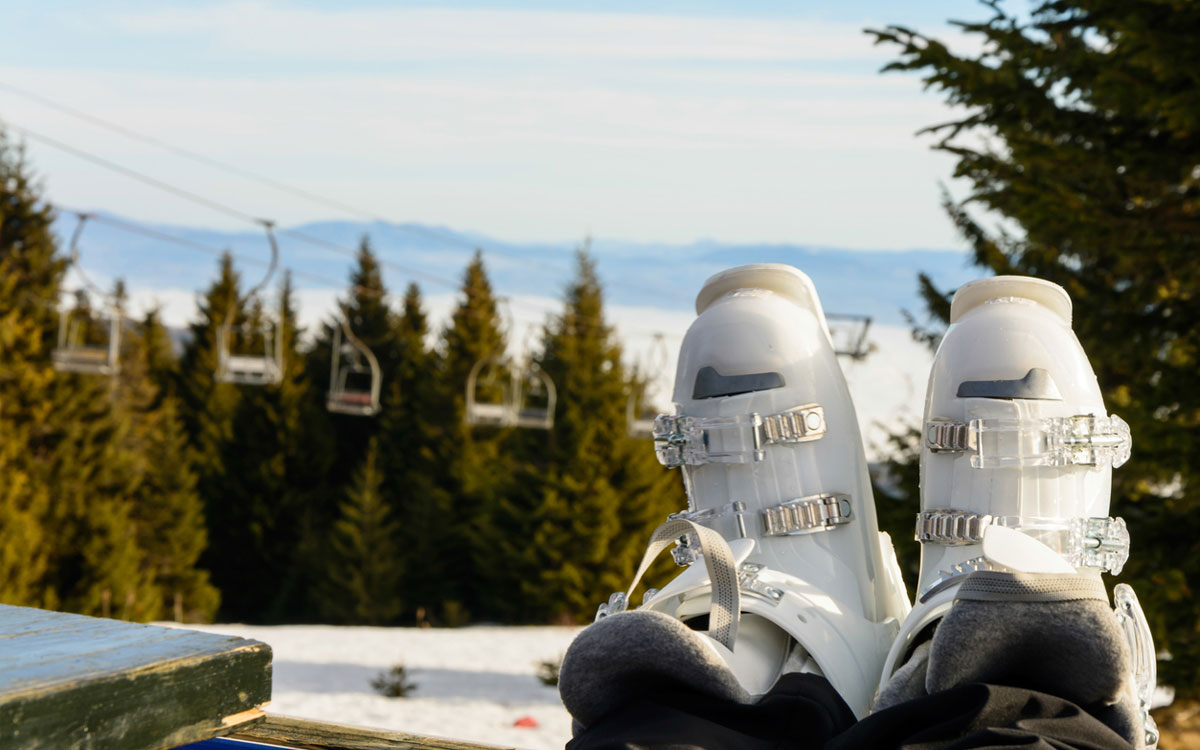
Boots are an important component of your ski kit. You should put the extra time and the energy to find out what pair of boots better suits you. Everyone’s foot is unique and every boot fits differently to every person.
The features of your boot depend on your ability level, aspirations, height, weight, and other factors. However, ski boots are complex, and finding the right one does pose a problem because there are some parameters to keep track of. But this guide can help you clear some of the confusion and make it easy for you to be able to choose your ski boots.
Flex
Choosing the flex of your boot is a great way to start. Almost all ski boots come with a flex rating. The range of the flex rating starts from 60 and goes all the way up to 140. The lower the flex rating the softer the boot and vice versa.
Boots with a low flex rating are soft and comfortable and so are adequate for beginners. These boots are forgiving on the feet but they provide less support. Since beginners aren’t aggressive as the intermediates and experts, they don’t need that much support. Soft boots are a great way to allow beginners to get used to ski boots.
Boots with increased stiffness are more suitable for intermediate and experts. The stiffer the boot gets the more uncomfortable it becomes. But the support increases as the stiffness increases which is necessary at high speeds. Stiff boots are uncomfortable but they allow efficient energy transfer and produce an instant response to handle high speeds.
One other factor that contributes to the determination of boot flex besides skill level is body weight. If you are a heavy person, you are going to need a stiffer boot to support your body weight. Boots need to be stiff enough to support body weight when skiing. A heavier person would produce more momentum even at low speeds. The boots should be stiff enough to support the momentum.
The general recommendations of boot flex based on ability level are as follows:
- Beginner: 70-90
- Intermediate: 90-110
- Advanced: 100-120
- Expert: 120+
Size
Ski boots are not sized like regular boots. Ski boot size is based on a separate scale called the Mondopoint. It is the base length of the foot in centimeters. If the length of your foot measures 27cm, then your Mondo size is 27.
Conversion of street shoe size to Mondopoint is an option but it is not recommended. Shoe sizes change from brand to brand or often don’t fit precisely. The conversion is never ideal and it should only be used as a last resort.
Besides, your actual Mondo size may be smaller than the one you measure up to because ski boots are recommended with a tight fit. Ski boot liners also become soft over time and leave space inside the boot making the boot feel loose. It is recommended that you start with a small size.
Width or Last
The width of the boot is also known as the last of the boot. It is measured in millimeters and is based on the width of the forefoot. Manufacturers offer boots with varying lasts but generally, there are three categories of last; narrow, average, and wide.
The last of the boot matters because as you go downhill, your feet experience side-to-side motion. If you don’t have enough space in your forefoot to compensate for this motion, then it will become uncomfortable. You should also have enough room for your toes to breathe and not feel stuffed.
Liner
Ski boots have a hard plastic outer shell that provides shape to the boot. The inner liner of the boot provides comfort and insulation to keep the feet warm. The liner is removable in almost all the boots available today.
In most ski boots, the liner has a two-piece design for added comfort. The amount of foam in the liner varies depending on use. Contrary to natural belief, getting the most push liner isn’t ideal at all. A plush liner would provide comfort, but it won’t provide the support you need on the hills especially during high speeds.
A liner that balances comfort and support is a preferred liner. It is also worth noting that the liner conforms to the shape of the feet. A boot that felt snug at first will slowly start feeling relaxed after some time of use. But when buying a boot, the liner shouldn’t feel too tight.
Heat-moldable Liners
Heat-moldable liners are of two types; liners that use body heat to conform to your foot’s shape and liners that are baked in a special oven. The benefit of a heat-moldable liner is that it provides a custom fit. These liners are extremely comfortable because of the precise fit that they provide.
For liners that require external heat, you would have to take them to a shop that has the proper equipment. You can also do it at home, but that is not recommended. After heating the liners, you wear them – after they reach a safe warm temperature – so that they conform to your foot’s shape.
Another benefit of heat-moldable liners is that they cut down the break-in period to mere hours or even minutes. So, you don’t have to waste half of your season breaking-in hard boots.
Buckles and Straps
For a long time, the four-buckle system has been considered a standard for adults. Performance boots still have a four-buckle system. There are two buckles across the foot, one at the bend near the ankle, and one along the shin.
Boots with three buckles remove the buckle at the ankle to save weight. But it is important to note that a four-buckle system is not necessarily better than a three-buckle system. If a boot with fewer buckles can provide the right fit and stabilize the boot then that is a better option. It will cut down weight and give a smoother profile to your boot.
The benefit of four buckles, however, is that they provide more options for local loosening and tightening. In most boots, the buckle closest to the toe is only decorative. So, a four-buckle system isn’t necessarily superior to others.
When looking for a ski boot, you should prefer the fit of your boot over the number of buckles that your boot has. If the fit of your boot is right for you, then the role of the buckles is reduced to fine-tuning only.
The strap at the top of the boot is called the power strap. It keeps the leg and the top portion of the boot locked in place for better performance. Adding a strap is a better option than adding a 5th buckle as it saves weight and is more comfortable. The buckles and the strap work together to achieve an excellent fit. They also make it easier to accommodate varying sizes of legs and feet.
Soles
You will find the two most common types of soles in ski boots; ISO 5355 Alpine and GripWalk. ISO 5355 is flat underfoot and is released from the toe piece on a standard alpine binding. Walking is not recommended with ISO soles as their flat profile makes them slippery on smooth surfaces like hard ice or even washroom tiles.
GripWalk soles are the newer soles with a rockered profile. It uses a plastic/rubber compound for traction. GripWalk is commonly found on high-end boots. When buying ski boots, you would have to make sure that soles are compatible with your ski bindings. New bindings are multi-norm ready.
Warmth
There has been a lot of improvement in liner technology over time. Modern boots have liners that are better insulators and are comfortable. So, you don’t need heavy-duty socks to keep your feet warm.



